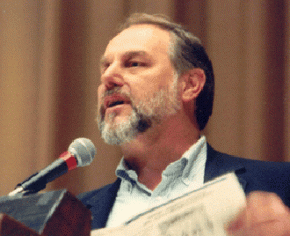The gift of the true organizer
Jerry Tucker, the former rank-and-file activist in the United Auto Workers (UAW), dissident regional director and a leading figure in the struggle for fighting unions in the U.S., died on October 19. , a retired autoworker and author of Autoworkers Under the Gun: Live Bait & Ammo, pays tribute to Tucker and his legacy of rank-and-file activism.
IN 2003, when I was researching work-to-rule--a process by which workers slow down production, drive up costs and thereby leverage negotiations--I called Dave Yettaw. Dave, a retired autoworker and former president from UAW Local 599 in Flint, Mich., was an old hand and trusted adviser. Dave told me that I should call Jerry Tucker, which to me was like saying, "If you want to learn about song writing you should call Bob Dylan."
Jerry Tucker was the most notorious living organizer of work-to-rule actions in the U.S. The 1991 version of A Troublemakers' Handbook by Dan LaBotz included a chapter that described Tucker's success with work-to-rule techniques at four different companies. Tucker was using work-to-rule to negotiate gains for workers at a time when the UAW was rolling backward faster than a gerbil wheel.
Dave gave me Jerry's number. I got up the nerve to call, and Jerry generously gave me a personal tutorial. It was the beginning of a friendship I will always treasure.
In the worst of times, Jerry was there for me. I am not alone in this regard. That's who he was. Jerry never told me what to do, but after talking with him, I felt I knew what I had to do next. That's the gift of a true organizer. It's because of such gifts that organizing will never die.

Jerry Tucker passed away October 19, 2012. When I got the call, I expected to hear Jerry's voice. I am not ashamed to say that when his daughter Tracy told me the news, I dropped to my knees and cried. I am not used to feeling so vulnerable. Even in death, he had another lesson for me. Whatever strength I may possess is dependent on other people.
JERRY'S PASSION for organizing was driven by his love and respect for fellow workers. If he was in it for the money, he would have kept his mouth shut. In 1986, when UAW members--frustrated by concession contracts, union cooperation with management and lackluster leadership--asked Tucker to run for regional director in upcoming union elections, Jerry understood the personal risks.
A challenge to the reigning director could cost him his career in the UAW, lucrative salary and benefits, and a cushy retirement. At the time, Tucker was the assistant regional director. If he followed protocol, he would inherit the position. Given his talents and experience, it was likely he could expect further advancement in the bureaucratic hierarchy. Protocol was the safe bet.
Tucker weighed the risk and came down on the side of his principles. It was, he told me, the choice he could live with. Fortunately, his wife Elaine is a woman who could live with a man most mothers of three children would call reckless and foolish. Without Elaine, Jerry Tucker wouldn't amount to a footnote, and Jerry was the first to admit it.
Tucker won the election after a federal court ordered a rerun based on evidence of the ruling administration's shenanigans. The victory cost him his career in the UAW, but not his vocation as an organizer or his reputation. He went on to organize union struggles such as Staley, a corn-processing plant in Decatur, Ill., where a sugar conglomerate, Tate & Lyle, was determined to break the union.
Tucker charged the members of the local union at Staley $100 for each day he spent on location. All expenses were on his own dime. Decatur is 120 miles from Jerry's home in St. Louis. I think it's fair to say it was a labor of love, without mitigating the biblical weight of the phrase. He drove that long, hard road for 40 months and left behind a struggle that organizers will draw lessons from for decades.
One of the hallmarks of Tucker's leadership in the UAW was the New Directions Movement. He was, in his own words, one of many co-founders of the New Directions Movement. Of the many, he was the most prominent and the one who paid the heaviest price for challenging the UAW hierarchy's backflip into corporate model unionism.
Jerry Tucker was a tower of conviction, a welder's jewel of commitment, and a man whose charisma was grounded in humility. He began with the premise that the rank and file knew the answers, not him.
Like many who knew him, I felt that Jerry Tucker was a great man. I didn't feel that I deserved his attention, yet he always treated me as if my needs were more important than his time. He conferred his dignity upon me and I left our conversation a better, stronger person. I am not unique. Jerry treated every working person with the same regard. Such is the gift of the true organizer. He uncovered leaders among the followers.
May his wife, Elaine, his daughters, Nicole, Tracy and Cynthia, and all of us who follow in his footsteps forever remember his most constant invocation, "Carry on! Carry on!"


